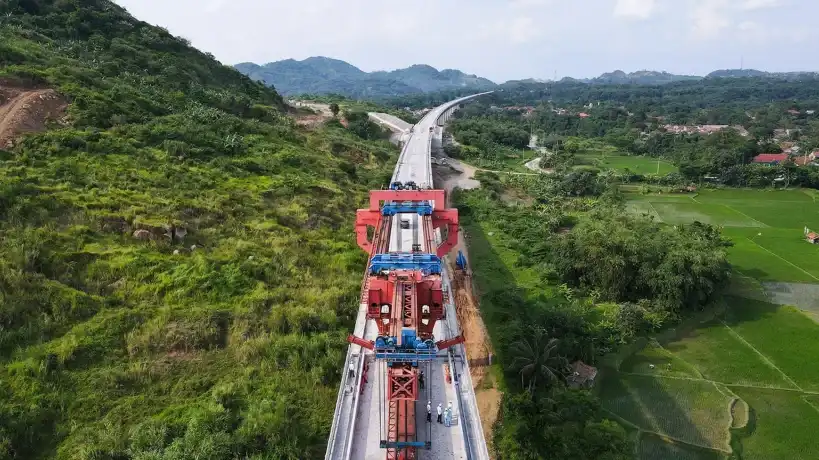The China-Kyrgyzstan-Uzbekistan (CKU) railway, slated for construction in October 2024, marks a pivotal advancement in Central Asia’s transport connectivity. By bridging key economic centres, this project not only enhances regional trade but also integrates Central Asia into the broader system of international transit routes. As the world increasingly turns to infrastructure development as a means of fostering economic growth and cooperation, the CKU railway stands out as a testament to the Belt and Road Initiative’s (BRI) role in shaping the future of global trade.
Central Asia has long been a crucial juncture in global trade routes, given its geographical positioning between major economic powers in the East and West. The CKU railway, which will stretch 486 kilometres from Kashgar in China through Kyrgyzstan to Andijan in Uzbekistan, exemplifies the region’s growing efforts to diversify trade relations and optimize transport routes. This diversification is not merely about creating new pathways; it’s about enhancing the region’s role in global trade by making it a critical link in a chain that connects Asia with Europe and the Middle East.
The strategic significance of the CKU railway is multifaceted. First, it will serve as a direct connection between China and the heart of Central Asia, facilitating the movement of goods and bolstering economic ties between the countries involved. This is in line with the broader goals of the BRI, which aims to improve trade connectivity and economic integration across Asia, Europe, and Africa.
The CKU railway is poised to transform Central Asia’s transit potential by offering new, more efficient routes for international trade. Currently, the region’s landlocked status limits its access to global markets, often requiring longer and more costly routes. The CKU railway will change this dynamic by providing direct access to key markets and reducing transit times and costs.
For instance, the CKU railway could become a vital component of several intercontinental trade routes, such as the Asia-Pacific-China-Kyrgyzstan-Uzbekistan-Turkmenistan-Azerbaijan-Georgia-Europe corridor. This route would enable the seamless movement of goods from China to Europe, passing through Central Asia and the South Caucasus. Additionally, the CKU railway could link with other significant trade corridors, such as the China-Persian Gulf route and the China-Europe route via Iran. These connections would further solidify Central Asia’s role as a critical hub in global trade networks.
Moreover, the CKU railway’s potential extends beyond just connecting existing routes. It could also pave the way for new corridors that link Central Asia to the Middle East and South Asia. For example, the CKU could connect with the Uzbekistan-Turkmenistan-Iran railway corridor, providing access to Iranian ports on the Persian Gulf and the Gulf of Oman. Alternatively, the CKU could be extended to Afghanistan, creating a corridor that links China, Kyrgyzstan, Uzbekistan, and Iran, with access to the Gulf countries. These possibilities underscore the transformative impact that the CKU railway could have on the region’s connectivity and economic prospects.
The CKU railway is more than just a transport project; it’s a catalyst for regional economic integration. By improving connectivity, the railway will enable the easier movement of goods, services, and people across borders, fostering closer economic ties between China, Kyrgyzstan, and Uzbekistan. This increased economic activity will likely spur investment in infrastructure, logistics, and related industries, creating jobs and driving economic growth in the region.
Furthermore, the CKU railway aligns with the broader objectives of the BRI, which seeks to promote inclusive development through enhanced connectivity. The BRI’s emphasis on infrastructure development as a means of economic integration is evident in the CKU project, which will not only connect countries but also integrate them into the global economy. As trade routes expand and diversify, Central Asia’s role in international trade will become increasingly prominent, positioning the region as a key player in global economic dynamics.
While the CKU railway presents numerous opportunities, it also comes with challenges that need to be addressed to maximize its benefits. One of the primary challenges is ensuring that the railway is constructed and operated in a manner that is both economically viable and environmentally sustainable. This requires careful planning and coordination among the countries involved, as well as investments in modern technology and infrastructure.
Another challenge is the need to harmonize customs and regulatory procedures across borders to facilitate the smooth movement of goods. The success of the CKU railway depends not only on the physical infrastructure but also on the efficiency of the administrative processes that govern cross-border trade. Streamlining these procedures will be crucial to realizing the full potential of the CKU railway.
Additionally, it is essential to ensure that the benefits of the CKU railway are shared equitably among the countries and communities involved. This includes creating opportunities for local businesses and workers, as well as investing in social and economic development in the regions along the railway. By addressing these challenges, the CKU railway can become a model for sustainable and inclusive infrastructure development in Central Asia.
The China-Kyrgyzstan-Uzbekistan railway is a landmark project that embodies the spirit of the Belt and Road Initiative. By enhancing transport connectivity in Central Asia, the CKU railway will unlock new economic opportunities, strengthen regional integration, and position the region as a key hub in global trade. As the construction of the railway begins in October 2024, it is crucial to recognize the transformative potential of this project and to work collaboratively to address the challenges and maximize its benefits. In doing so, the CKU railway can become a cornerstone of Central Asia’s economic future and a vital link in the global economy.
(qaisernawab098@gmail.com)










